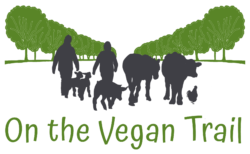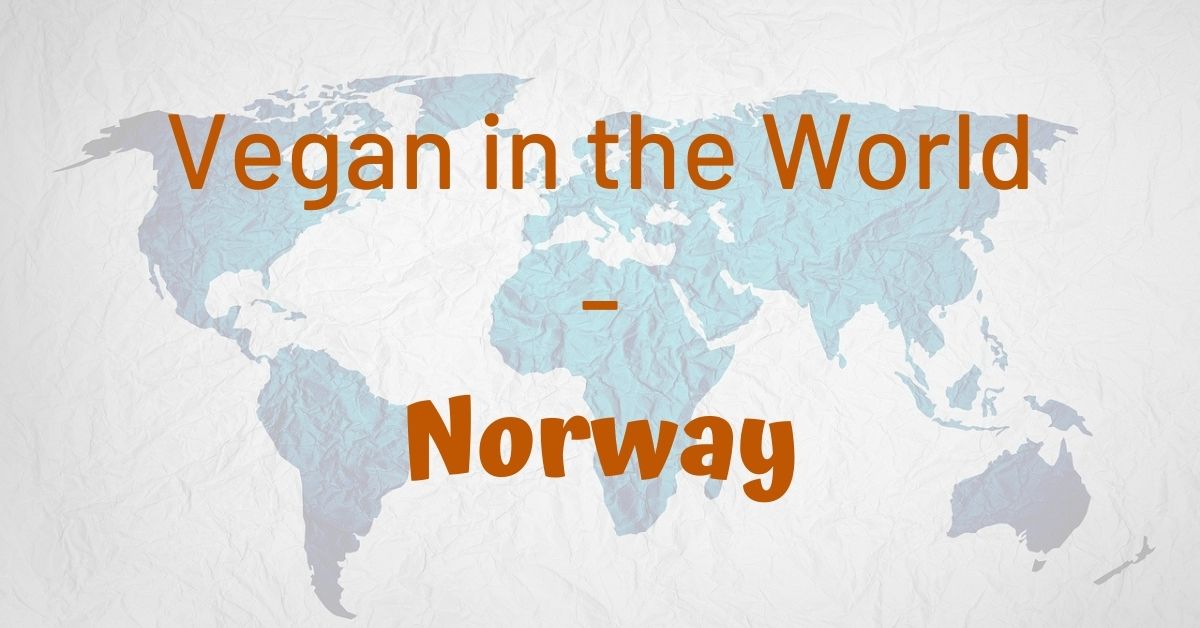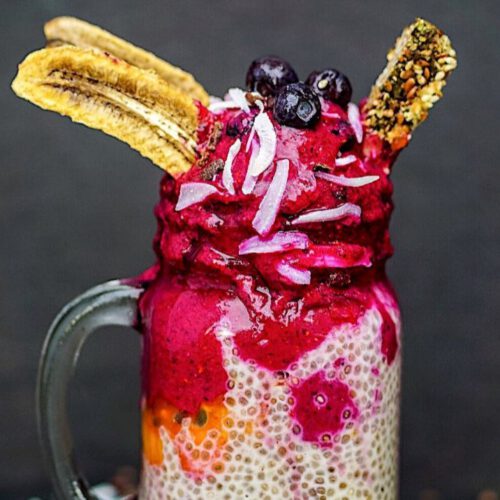What it is like to be vegan in: Norway
In this fourth article in the 'Vegan in the World' series, in which vegans from all over the world explain what it is like to be vegan there, Simen Li tells about his experiences of being vegan in Norway.
Interview with Simen Li from Norway
How many people live in Norway, and how many of those people are vegan?
There are approximately 5.279 million inhabitants, 213.000 of those are vegan.
How long have you been vegan?
I have been vegan for 7 years.
Why did you decide to become vegan?
One day I just had a realization that animals have feelings and then I went vegan.
Tell me a little bit more about your family. Are they vegan? What do they think about you being a vegan?
They are not yet vegan but are eating healthier and more plants. They are learning more and more and realizing more and more that there might be something to it. They are supportive.
Is it easy to be a vegan in your country? Why (not)?
Yes, it is very easy. It does require some extra focus on getting enough minerals because the fruits can be more mature. I am very often in warmer climates and a big reason for that is the natural fruit accessibility, it makes a big difference.
With that said, Norway has plenty of food options and many stores provide good quality organic food. We have many restaurants that are vegan as well, and veganism is increasing with more and more new vegan restaurants opening.
As long as we get enough minerals, and go in the sun sometimes, and preferably travel to warmer countries in the winter to get more sunlight through the skin, it is easy and we can thrive. I love health food stores because they provide more foods that are grown in mineral-rich soils. With some powders and imported exotic fruits that are relatively ripe, I can get everything I require to feel my best as a vegan in Norway.
What are some of the challenges you face in your daily life as a vegan?
I don't face any challenges regarding being vegan, it only provides many big benefits.
Is it easy to eat out with friends or visit family? Do you have to bring your own food?
It is very easy and friends and family are very accommodating. I do bring my own food as well sometimes, but I also make sure I avoid nightshades and onions because I am sensitive to that. Although my family even accommodates to that, I find it easier to bring my own food sometimes. So it is just easy, and if I bring nice looking food, people find it interesting as well. I am very healthy so it inspires my family as well when I bring beautiful healthy foods. And they like it as well. Especially the most positive people in the family. But everybody is interested and asks me more and more for health inputs.
“I am very healthy so it inspires my family as well when I bring beautiful healthy foods.”
- Simen
Can you describe what you eat on a normal/average day for breakfast, lunch and dinner?
On a normal day, I eat multiple meals.
I structure my day differently than most people, but it works incredibly well and in my view is more natural.
I often start the day with 750 ml or more coconut water. I might add spirulina every fifth day, and pine pollen some days. This is for hydration and some protein additions as well as broad-spectrum mineral additions.
Then I eat a big fruit meal. For example, papaya, until I am satiated. That is followed by multiple herbs after 15 minutes, including gynostemma, holy basil, gotu kola, mucuna (every other day), bacopa, osmanthus, rose, hawthorn, schizandra, and more herbs. This produces very positive feelings. I also drink bhringraj powder for the hair. It is the best herb I have found for the hair. It really works in addition to the foundation I describe here with multiple fruit meals, greens, and some amino acid sources. I also drink camu camu powder mixed with coconut water from a glass or husk.
An hour later I eat another big fruit meal. And another big fruit meal one hour after that.
Then I eat a salad with some protein source. This could be bloomed raw heated wild rice, or chickpeas cooked, or pea protein powder with bromalain and papain enzymes. Or fresh edible legumes from the garden soaked. I add some dressing or something tasty with this and eat leafy food equivalent to one or two full lettuce heads.
Three hours later I eat a big bowl with wild blueberries, mixed berries and drink a glass or two with frozen acai.
One hour after that I eat a salad with avocado, olives, and some protein-containing foods. For instance, pine nuts, walnuts, Brazil nuts or something similar. Plus tasty seasoning and a healthy dressing.
In the first protein meal, I have high protein with low fat. In the second I have a high protein intake with some fat. I also have some chia seed pudding with cinnamon, soaked in plant milk for 4 hours with vanilla and some sea salt.
Then 3 hours later I have a final fruit meal. I might also drink coconut water at other times of the day and include cucumber somewhere and other foods with either one of the protein meals.
Sometimes I might eat something else as well, and include different herbs as well for different effects that I feel like. I take zinc supplements sometimes as well.
I love to get plenty of color-rich foods in during the day and go high on the greens and make sure I get enough calories.
What kinds of vegan products are available in your country besides vegetables? Are they affordable for most people?
Everything. Yes, they are affordable to most people in Norway.
Can you tell us about some of your country's traditional dishes?
I think most traditional "dishes" are non-vegan, so I say wild picked blueberries instead as a more positive tradition, which is something that grows a lot in the wild.
Are they easy to veganise? Which is/are your favorite?
All the dishes commonly eaten for Christmas or New Years are easy to veganise. I like nut steak for example. In Norway brown cheese from goat is regularly eaten. I haven't seen that done in vegan form, but from pretty much everything else I have seen vegan equivalents. Norway has plenty of vegan dishes in the stores, but I focus mostly on whole foods and mix some things together for the protein-containing meals so they taste good.
One time when I was in Sayuri, on Bali, I found a vegan version of gravlaks which is a smoked salmon dish. It tasted so much like fish that I preferred something else. But other people came specifically to the restaurant to eat that dish on the day when it was a special. So even things like that are veganised, and people like it.
Anyway, what causes good taste in almost all cases for people is fruits, herbs and salt, plus some other things like cinnamon bark etc. Sugar, as extracted from sugar cane, is a hybrid herb. Spices are herbs, and more herbs taste great as well.
The best foods I have eaten in my life are free and complete persimmon and avocado from plants with really good genetics and grown in mineral-rich soils. Also, by eating at the best vegan restaurants in Bali for a year I learned a lot. The food at Sayuri Ubud and Seeds of Life is world-class when it comes to vegan food combining great health and great taste.
I have given tips to restaurants in Norway, so eventually, the restaurants in Norway will also reach the level the best vegan restaurants in Ubud, Bali are at today. They have been 10 or 20 years ahead of almost all other places on Earth when it comes to vegan food. I also consult vegan restaurants, hotels and wellness centers so I have found many success factors for taste and more ideal vegan food both for thriving and regarding taste.
Can you recommend a restaurant where you live?
In Norway, the level can honestly be better and will be but if I had to recommend some I'd say that the best one I have eaten at is Vegan Hut in Oslo, for taste. Although it can be healthier, the falafel tastes very good. Another one I would recommend is Nordvegan in Oslo. There are more restaurants in different places, and new ones opening.
Please share a recipe if you have one.
A recipe I like just for getting more omega 3 is to have a big jar or glass with chia pudding as the base. Soaked for 4 to 6 hours with plant milk, Ceylon Cinnamon, vanilla and sea salt. Then I blend greens with avocado and apple juice plus dates. Although I don't normally mix fruits and fat except for fatty fruits which go well with either fat-containing seeds/nuts. Then I add that on top of the chia pudding, the green shake should be thick like a yogurt. You can add other ingredients to the thick green shake as you feel, regarding taste.
You can also make a thick red smoothie on top of that if you want, with greens and some red fruit and bananas for example. I usually just have the chia pudding with a thick green shake on top, with some sweetening for taste. Then I add coconut flakes on top. But you can also add a protein bar or something in it or other things to decorate it. I learned this in Seeds of Life Ubud by ordering it and looking at the menu and asking what the ingredients were and tasting.
This is something you can do a lot with and looks impressive. But regarding sharing with people, they have to be created individually if more people are to try it. You can make it look really great and impressive with different layers and toppings. You can also add foods on top, like chocolate half-covered strawberries on sticks on top, like a gift basket.
Is there an active vegan community where you live and are you a member?
Yes, there are very kind vegan groups that meet in Stavanger and other cities.
If you have a vegan business or work at a vegan business, can you tell us something about it? What is the business, when did it start?
My company is called Bliss Immersions.
I have coached many people now to thrive as vegans.
I have consulted multiple vegan hotels, wellness centers and restaurants and some even became all vegan and organic because I suggested it.
So, I do both coaching for people that choose to be much more vital as vegans and consult wellness companies.
I also get paid for making herbal mixes as a consultant. And I am focusing on facilitating people buying elegant edible landscaping by connecting customers and the best garden designers and food forestry experts. Food forestry is about using wild edible trees and plants and go along with nature's growth when forming the design, so it is self-maintaining. It looks great and provides food for people. This can also be done in Norway with things like apples, pears, and many more fruit trees and winter salads.
Is there anything else you would like to share with us about being vegan in your country?
It is great when it comes to shops, and if you have fruit trees in your garden, that greatly increases mature fruit variety during many months in the year which is beneficial. But I do very frequently travel to warmer places in the summer.




